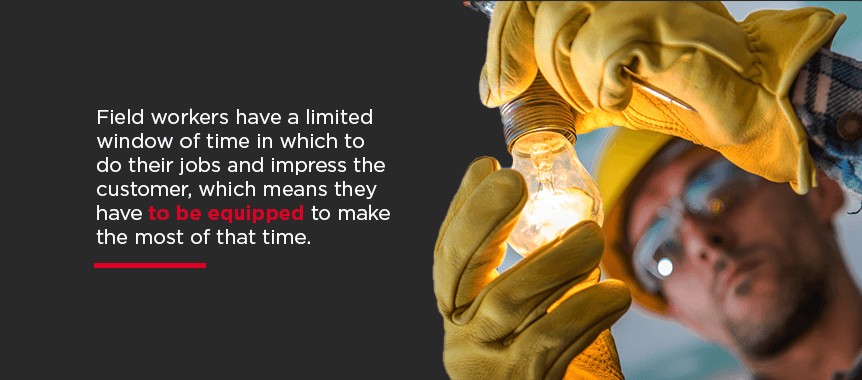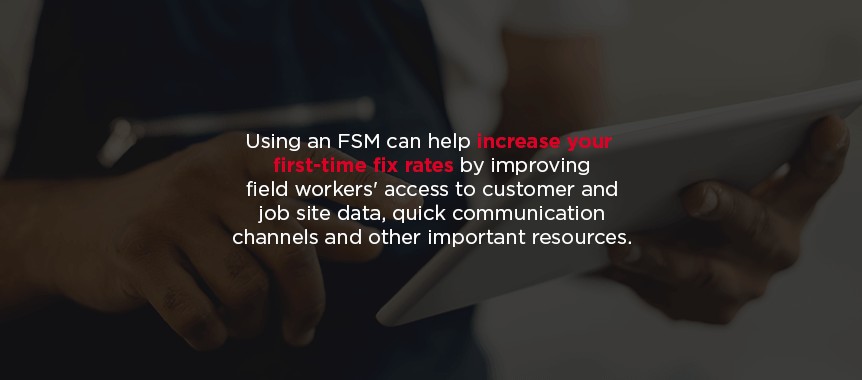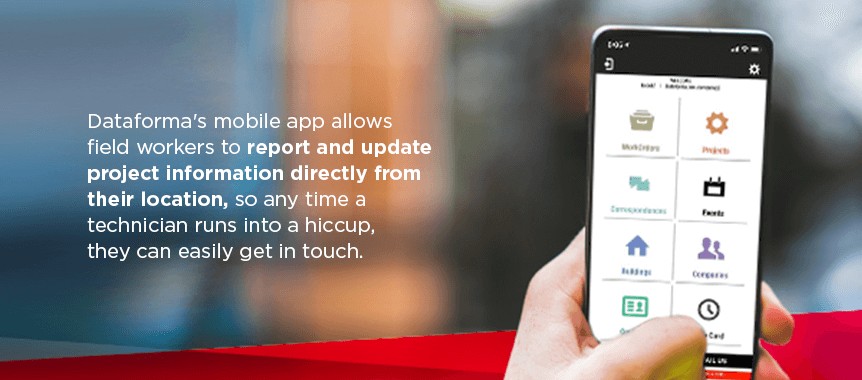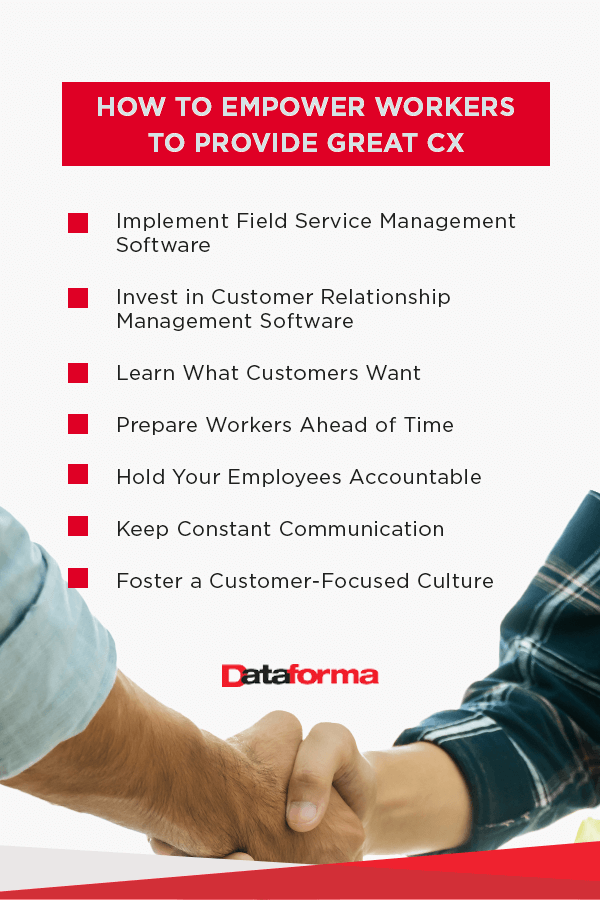In its simplest definition, the customer experience (CX) is the interaction between a customer and your company. From their first encounter with your advertisements to the completion of their work order, customers form an opinion of your brand. If a customer feels they had a positive experience with your company, they’re more likely to choose you for similar jobs in the future.
Why does CX matter so much? That’s what people look for when they choose their service providers — almost 74% of Americans prioritize great experiences over products. So, while essential industries like plumbing and roofing will always have work, providing an excellent customer experience is key to ensuring people continually choose your company over others. After all, it’s common knowledge that acquiring new customers is more expensive than retaining existing ones.
In this post, we’ll go over the most common CX challenges that field service organizations face today and potential solutions for improving your CX strategy.
Why Field Service Is So Important
Your company might make most of its money selling products, but if your customers lack the skills or knowledge to use that product, they’re likely to grow frustrated. Providing field service keeps the relationship going beyond the initial purchase. Your customers can rely on your company for more than just a quality product — they’ll also turn to you for help any time they need it.
Additionally, field service helps put a face to your business. While your customers will be in contact with your company long before their appointment, they probably won’t interact with you in person until a service technician arrives. Professional, efficient field service is crucial for making a good impression.

Field workers have a limited window of time in which to do their jobs and impress the customer, which means they have to be equipped to make the most of that time. While there are many challenges to optimizing field service and creating the best customer experience, it’s still an achievable and worthwhile goal.
Top 6 Challenges of Providing Great CX in Field Service
Customer experience is important for organizations across all industries, but due to the mobile nature of fieldwork, service technicians and managers face a unique set of challenges.
Some of the most common include document storage and organization, scheduling issues, worker accountability and ever-changing customer expectations. Improving your field service management strategy is often the best way to overcome these obstacles.
1. Shifting Customer Expectations
As technology rapidly evolves, so do customer expectations. For example, you might advertise your services on Facebook or another social media network. If a customer finds you through these ads, they may expect you to use a fully digital system — when they discover you’re still relying on pen and paper, they could be disappointed.
Essentially, today’s customer expectations boil down to two points:
- Lower tolerance for mistakes and miscommunication
- A desire for simpler, faster service
Leveraging a digital solution like Dataforma can help you meet your customers’ expectations. For example, most people nowadays avoid making phone calls, preferring to use messaging systems or automated processes instead. Providing a self-service customer portal is a great way to make the customer experience more seamless.

2. Document Storage and Organization
Sifting through stacks of papers to match paperwork to customer accounts is time-consuming and inefficient. By the time you manage to get around to the customer, they may have decided to take their business elsewhere next time.
Switching to a virtual field service management (FSM) solution like Dataforma allows you to transfer all that information to one easy-to-navigate platform. Utilizing cloud technology, you can store business information, customer data and other key information in one place you and your workers can access anytime, anywhere from an internet-connected device.
A robust FSM platform also simplifies data entry for the contractor. Using a pen-and-paper system, a field worker often takes notes about the job during their appointment and transcribes that information into the organization’s digital system whenever they can find the time. In contrast, an FSM system allows workers to enter their notes directly into the client’s profile in real time. As a result, there’s less risk of human error.
With the accurate information at hand, your techs will be better prepared for each job, which enables them to provide excellent service the first time.
3. First-Time Fix Rate
When customers request a service from you, they expect the technician who shows up to provide an effective solution the first time around. However, variables like scheduling delays, miscommunication and parts inventory mismanagement can lower the chances a specific job will go right the first time.

Using an FSM can help increase your first-time fix rates by improving field workers’ access to customer and job site data, quick communication channels and other important resources. You can also leverage your FSM to help you find the best technician for the job — having the most qualified worker for a specific project can help you increase the chances of a first-time fix.
4. Worker Accountability
Consistency is key to the customer experience. For example, let’s say a previous customer schedules a new appointment with your company. Their last experience was fantastic — the technician performed a thorough inspection of their problem, answered any questions that came up and did it all with a smile. However, the technician that came to their next appointment was surly and disorganized. Despite their previous satisfaction, the customer is likely to go elsewhere the next time they need a similar service.
Workers always need to take responsibility for their actions, even when they make mistakes. It’s easy for some employees to place the blame for a failed job on someone else, but when workers hold themselves accountable for their actions, they’re more likely to produce good results. That goes for providing good customer service, as well. Implementing a service management solution with GPS tracking and service capabilities is one way to keep tabs on your team’s behavior in the field.
Look for an FSM solution with a mobile time card feature — your employees can clock in and out without having to deal with a physical time card, which enables more efficient, accurate time tracking for everyone in your organization. With more accurate information about how long employees are working, you can get a better idea of what a realistic schedule would look like. By avoiding overbooking, you can ensure workers get to job sites on time, which improves the customer experience.
5. Unexpected Developments
Situations can change in an instant when workers are in the field. While unexpected circumstances can make completing a job more difficult, the way you and your service technicians react to the change is what really affects the customer experience. Real-time communication allows technicians to instantaneously inform the back office or client any time a potential issue arises, whether they’re stuck in traffic or missing a part that’s necessary for completing the job.

Dataforma’s mobile app allows field workers to report and update project information directly from their location, so any time a technician runs into a hiccup, they can easily get in touch. It also includes the following features to boost efficiency:
- Custom checklists and inspection reports
- Ability to email reports to the office or customer
- Upload project photos
- Record site conditions before and after beginning work
- GPS tracking functionality
6. Safety Concerns
Regardless of job type or location, safety is crucial for both your workers and your clients. However, when your organization lacks an effective means of enforcing industry rules and regulations, it can be difficult to make sure your technicians are doing what they should when in the field.
Field service management helps protect your workers from risks like falls, exposure to hazardous materials and inclement weather. Prioritizing safety also ensures your customers get the best results possible since adhering to regulations means your workers are getting the job done right.
Several ways you can increase safety measures using FSM include:
- Documenting hours through mobile timesheets or GPS tracking
- Providing detailed procedures in work orders and forms
- Creating and sticking to preventive maintenance schedules to ensure equipment is in good condition
- Using the work order to inform customers of any potential risks
- Attaching photo evidence of completed work to a work order
- Tracking a work order’s history through an audit log

How to Empower Workers to Provide Great CX
Your field workers are often the only members of your organization to interact with your customers face-to-face.
Start by breaking the customer experience into chunks you can easily manage and consider how you can make them more cohesive. For instance, since people have become so accustomed to reaching out to companies online, implementing a program that allows them to access service information and schedule appointments without having to pick up the phone is a great way to meet their expectations.
Of course, there are many other ways to facilitate great customer experiences. Getting your workers involved is a crucial step toward creating lasting customer relationships.
1. Implement Field Service Management Software
If you’ve been looking for an easy way to modernize and optimize your business processes, consider investing in a field service management (FSM) program. FSM software can help you figure out how to streamline your operations and more effectively leverage the resources you already have.
What is field service management? The term refers to everyday business processes like assigning workers to work orders, scheduling appointments, dispatching and communicating with workers in the field and managing supply inventory.
An FSM program like Dataforma streamlines these processes by:
- Reducing physical paperwork
- Improving job scheduling
- Simplifying work orders
- Increasing worker visibility
- Tracking job statuses
- Boosting productivity
- Lowering costs
2. Invest in Customer Relationship Management Software

A good customer relationship management (CRM) software program is crucial to forming and maintaining strong relationships with your customers.
A CRM system allows you to efficiently collect, organize and manage customer data in one convenient location. With Dataforma’s Core CRM, businesses of all sizes can reach clients more effectively and keep track of their data on one convenient platform. It also integrates directly into our FSM application.
Some of the benefits of using our Core CRM include:
- Less time spent managing work orders
- Accurate, instantaneous job status updates
- Paperless document storage
- Mobile app functionality
- Digital invoicing
- Lead tracking
3. Learn What Customers Want
It’s not always easy to figure out customer expectations from reading reviews alone. After all, customers who have positive experiences with your company are significantly less likely to leave a review than customers who have negative experiences. Additionally, most people don’t leave long, detailed reviews that outline every factor that contributed to their poor experience.
When you focus on meeting your customers’ wants in addition to their immediate needs, you can more effectively prevent the negative experiences that lead to poor reviews. Creating a strong voice of customer (VoC) program can help you determine what specific things you need to improve to gain more customer approval.
Here are some methods for creating this program:
- Create a feedback form: Write a dedicated feedback form and present it to your clients. One way to ensure customers participate is by having your service technicians administer the survey — provide your workers with a tablet or other mobile device that can handle survey technology. Customers can easily fill out the form at the end of the job while your worker cleans up.
- Read customer reviews: Review sites like Yelp, TrustPilot, the Better Business Bureau (BBB) and Manta are gold mines for customer feedback. List your businesses if you still need to and read the reviews that come in, taking note of any patterns you notice. You can also integrate the function to leave reviews through a customer portal, which can make the process easier for both you and your customers.
- Interact on social media: In this digital age, having a presence on social networking platforms is a great way to connect with customers and boost your advertising strategy. Customers can comment on your page or direct message your representatives, which can provide insights beyond a simple review, as you can ask them follow-up questions about their input.
- Conduct online surveys: Give your customers a link to an online survey that asks questions about their experience, including what they liked and areas where you can improve. You can send surveys in a variety of ways, including sending a link through email or posting the survey directly on your website or social media pages.
Once you’ve gathered some customer data, identify any trends and common themes you see and use them to create an action plan. For example, if many customers mention they wish there were more ways to request services beyond calling your office, consider implementing a more convenient option like online scheduling.
4. Prepare Workers Ahead of Time
When your workers know what to expect, they’ll be in the best situation to provide great service. After all, a prepared technician inspires more confidence in customers than someone who seems unsure of their duties.
Access to a CRM allows field workers to easily view important customer information like work history and site characteristics, which can help them determine the best way to tackle the job before they arrive at the job. For example, Dataforma’s CRM software allows field workers to view detailed profiles for each customer, which contains valuable information like existing site conditions and work order history.
When your team knows what to expect, they’ll be in the best shape to deliver great service.
5. Hold Your Employees Accountable
Monitoring your field technicians via GPS is essential in keeping your employees on track. Dataforma’s GPS tracker integrates fully with our Core CRM and FSM platform, providing a streamlined solution for your operation.
Keeping an eye on metrics like time to site and time to completion can help you optimize field service processes. For example, if you know your technicians take a long time to complete jobs, you can use this information to figure out what specific factor is influencing it. Once you know what to look for, you can find ways to cut this time so customers don’t have to wait as long for their requested service to be completed.
This data is also useful for billing purposes, as you can use the GPS data to verify the actual hours worked. You can provide your customers peace of mind with the knowledge they’ll only receive a bill for the hours your technician spent on site. Plus, having GPS access can make job sites easier to find, which reduces the chances your workers will show up late.
6. Keep Constant Communication
Maintaining open, consistent channels of communication with your customers is crucial to providing a good customer experience. Updating customers throughout the service process helps build trust in your company. When something changes, sending a brief message to keep your customer informed shows you value them and genuinely want to provide good service.
For example, Dataforma’s software automatically notifies customers any time a technician will be late to a job. It also sends an alert to the back office in the event of an emergency. Customers will appreciate that you took the time to keep them informed, and you’ll be able to solve any unexpected problems before they become unmanageable.
7. Foster a Customer-Focused Culture

A customer-focused culture puts the customer at the center of your operations. When your field workers know the true importance of their role in the customer experience, they’ll feel more motivated to work with the customer to reach their goal.
Here are three important steps to take toward developing a customer-centric organization:
- Know what customers like: Ask yourself the following questions. What makes your service valuable to your customers? Why do repeat customers choose your service above others? Use these reasons to inform any improvements you may choose to implement later.
- Invest in effective decision-making: When making business decisions, you should always consider how they’ll affect your customers. You can use the data you collect in your CRM and any customer feedback you’ve received to inform your decision-making process.
- Engage your workers: Provide your team with the opportunity to share their ideas about how they can work to improve the customer experience. Doing so will help them feel more connected to their own roles in the process. It can also help you find new ways to improve that you may have previously overlooked.

Try Dataforma’s Core CRM Software for Free
At Dataforma, we know customer relationships go hand in hand with effective field service management. That’s why our founders created our original CRM — to provide service management companies of all sizes with a robust solution that enables them to save time, save money, and reach clients more effectively.
The current version of our Core CRM integrates seamlessly with our FSM software to provide a simple, all-in-one solution for streamlining service operations and enhancing the customer experience. With other helpful features like mobile time cards, GPS tracking and a convenient mobile app, we’re confident we can provide you with the best software for your company’s needs.
See how we’ve helped more than 11,000 field service workers across the U.S. and Canada provide top-tier CX to their customers. Request a free demo today to try our software out before you make a full commitment. We’ll get back to you within 24-48 hours to set up a meeting.










